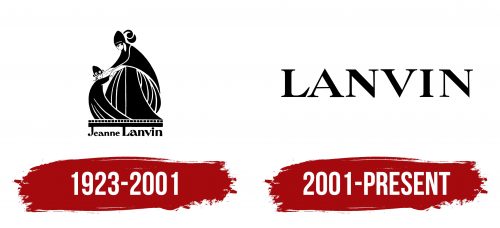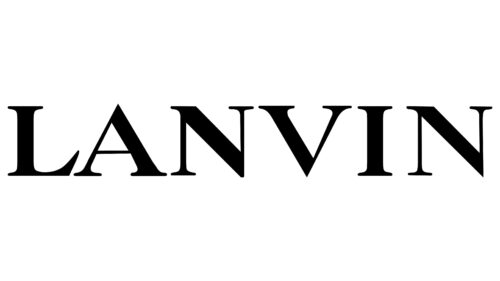Lanvin Logo PNG
The Lanvin logo undoubtedly stands out with its stylish and modern appearance, reflecting every piece’s elegance and refined beauty from this legendary fashion house. The charm of women’s attire played an important role in shaping the brand, and every element seems to refer to this history, precisely highlighting its uniqueness.
Every woman’s look is unique, and the company’s products, whether bags, perfumes, or clothing, are also distinguished by their individuality. The visual symbol, created in a minimalist style, conveys classic accents, but behind this outward simplicity lies a deep authenticity. Although the brand is rooted in tradition, its main value is each item’s unique character and original brilliance.
The emblem’s elegance and refinement combine with its distinctive sophistication. In its lines, one can sense the inspiration that permeates all of the brand’s creations. A love for beauty and aesthetics is evident in all the details, symbolizing sophistication and admiration.
Lanvin: Brand overview
Lanvin’s history began in 1889 when 22-year-old Jeanne Lanvin opened a small hat shop in Paris on Rue du Faubourg Saint-Honoré. With her talent and ambition, she quickly gained recognition for creating exquisite hats for the Parisian elite.
In 1897, Jeanne’s daughter, Marguerite, was born, and she became the inspiration for many of Jeanne’s innovative designs. Jeanne started making beautiful clothes for her daughter, which caught the attention of wealthy clients. This marked the transition from headwear to a full clothing line.
1909 the house officially joined the Syndicate of Haute Couture, a significant milestone for Parisian haute couture. This allowed Jeanne to expand her client base and present her creations at prestigious events.
The 1920s were a golden era for the company. Jeanne’s distinctive style, known for its soft pastel colors, intricate embroidery, and graceful silhouettes, became highly popular. Her “robes de style,” featuring long skirts and low waists, were particularly admired.
In 1924, the fashion house launched its first perfume line. The fragrance “My Sin” succeeded, solidifying the brand’s place in the luxury market. 1927, the renowned “Arpège” perfume was introduced to celebrate Marguerite’s 30th birthday.
During the 1930s, the brand continued to grow, expanding into men’s clothing, lingerie, and furs. It also ventured into home décor, allowing customers to style their homes with the label’s signature elegance.
When Jeanne passed away in 1946, she left behind a thriving company. Her daughter Marguerite took over the business, continuing her mother’s legacy.
Throughout the 1950s and 1960s, the house maintained its status in haute couture by adapting to changing fashion trends. Perfumes remained a symbol of French elegance.
The 19 remained a symbol of French elegance. The 1970s and 1980s were a period of transition for the company. After Marguerite died in 1958, the business underwent several changes in ownership. Despite these shifts, the brand stayed true to its roots and continued producing high fashion.
In 1989, the fashion house celebrated its 100th anniversary, cementing its place as one of France’s most enduring fashion houses. Special collections and events highlighted the brand’s rich history.
A turning point came in 2001 when Alber Elbaz was appointed creative director. Under his leadership, the house regained its prominence in the fashion world. Elbaz modernized the brand while preserving its timeless elegance, earning critical praise and attracting a younger audience.
In 2010, the brand collaborated with H&M to launch a clothing line, introducing it to new markets. The partnership was a major success and increased its appeal to younger consumers.
Alber Elbaz’s sudden departure in 2015 shocked the fashion world, leaving the company searching for a new creative direction.
In 2018, Fosun International, a Chinese investment firm, acquired a majority stake in the business, ushering in a new era of stability and growth. Bruno Sialelli was appointed creative director in 2019, tasked with revitalizing the brand while staying true to its heritage. His designs combined the label’s classic elegance with contemporary trends.
In 2021 and 2022, the company experienced a resurgence, improving its online presence through expanded social media marketing and e-commerce. It also introduced new accessory and fragrance lines.
By early 2023, the house continued to evolve, balancing its rich heritage with modern fashion trends. It remained a symbol of French luxury and sophistication, adapting to the changing global market while preserving the values established by Jeanne Lanvin.
In its 130-plus years, the fashion house has grown from a small hat shop into a globally recognized luxury brand. Throughout its history, it has maintained its unique identity and commitment to the standards of style and excellence set by its founder, Jeanne.
Meaning and History
What is Lanvin?
This is the oldest French designer label still in operation, serving as a prime example of Parisian elegance and refinement in luxury fashion. Known for its craftsmanship and attention to detail, it has developed a unique style that blends modernity with classic sophistication. The brand’s collections feature elegant yet strong silhouettes adorned with intricate details and made from luxurious fabrics. In addition to haute couture and ready-to-wear clothing, the brand offers accessories, fragrances, and even children’s clothing, all maintaining the brand’s distinctive aesthetic. Fans appreciate its evening gowns and iconic ballet flats, symbolizing French style and refined luxury.
1923 – 2001
The brand’s story began with one special photograph, which laid the foundation for the future establishment of the Lanvin fashion house. The birth of her daughter was a significant event in Jeanne Lanvin’s life, and the moment captured at a ball played a key role in the creation of the brand. When Jeanne and her daughter appeared in striking, coordinated outfits, their looks could not go unnoticed. This photo inspired illustrator Paul Iribe, who transformed it into the first logo of the fashion house. Iribe added artistic details, giving it graphic expressiveness and realism, infusing the image with a unique aesthetic.
The first logo became a true work of art, surpassing the role of a simple emblem. It doesn’t shine with bright colors, but its simplicity and black-and-white palette carry deep meanings. The main idea of the visual symbol is the eternal bond between mother and daughter, spiritual and continuous, passing from generation to generation. This seemingly simple element conveys a multilayered story of love and legacy.
Although the portraits do not play a central role, attention is focused on the exquisite outfits, reflecting the lady’s style and elegance. At the bottom, the name of the brand’s founder—Jeanne Lanvin—is written concisely in neat, strict, and small letters, placed beneath a dark horizontal line. This emphasizes the importance of the drawing itself and gives the entire composition strength and completeness.
2001 – today
In 2001, the brand’s logo changed. By this time, the fashion house had achieved such renown that it no longer needed complex visual imagery. Thanks to their refined aesthetics and grace, this brand’s clothing, shoes, accessories, and perfumes have won customers’ hearts.
The Lanvin logo embodies classic elegance, reflecting the brand’s history and sophisticated style. The first thing that stands out is its strict minimalism. All attention is focused on the name itself, which is entirely justified since it has long been a symbol of high quality and luxury.
The serifed font gives the letters sophistication, clarity, and charm. Each letter is neatly spaced at equal distances from one another, creating a sense of harmony and order. The serifs make the logo strict and expressive, emphasizing the brand’s unique style, which has always balanced classic and modern.
The color scheme is simple—black text on a white background. This color doesn’t distract from the main focus—the name itself. Black symbolizes strictness and confidence, while the white background creates a sense of purity and openness. Together, these two colors give the emblem timeless relevance, making it look modern even decades later.
From the very beginning, the brand embodied luxury and individual style. Its emblem stands like a beacon among other fashion houses—strict, concise, yet refined and maintaining its significance. This brand has always strived to create clothing and accessories of the highest quality.






